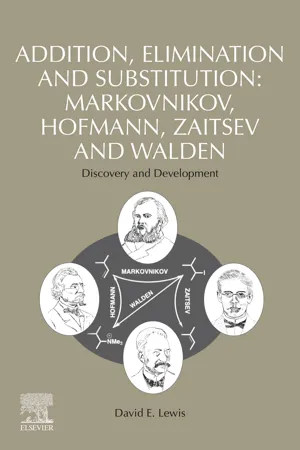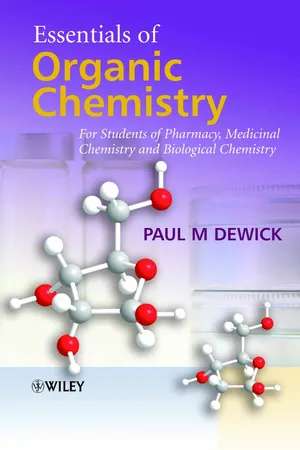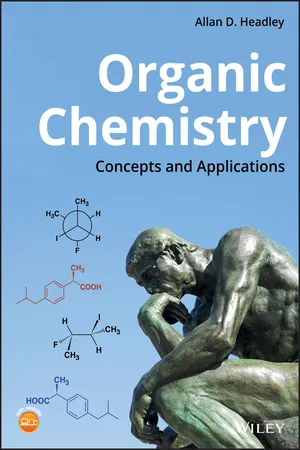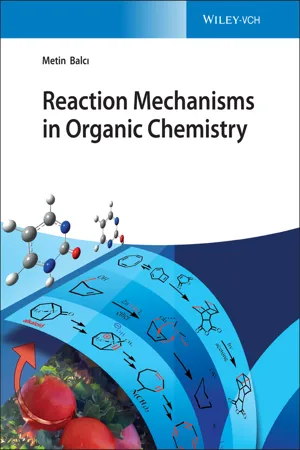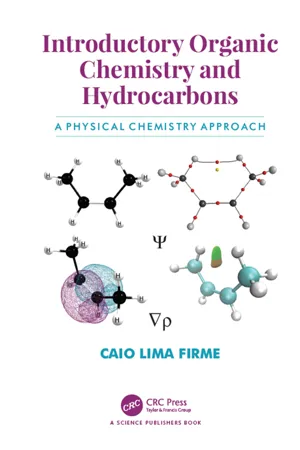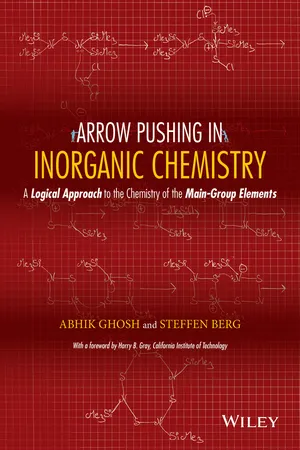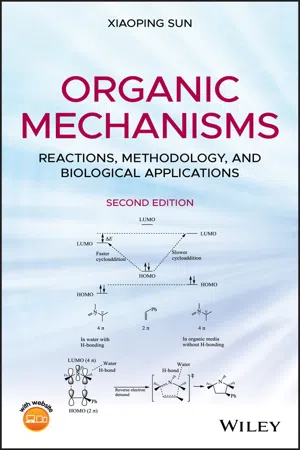Chemistry
Markovnikov Rule
The Markovnikov Rule is a principle in organic chemistry that states that when a hydrogen halide (HX) is added to an unsymmetrical alkene, the hydrogen atom of HX attaches to the carbon atom that has the most hydrogen atoms already attached to it. This rule helps predict the outcome of reactions involving unsymmetrical alkenes and hydrogen halides.
Written by Perlego with AI-assistance
Related key terms
Related key terms
1 of 4
Related key terms
1 of 3
7 Key excerpts on "Markovnikov Rule"
- eBook - ePub
Addition, Elimination and Substitution: Markovnikov, Hofmann, Zaitsev and Walden
Discovery and Development
- David E. Lewis(Author)
- 2022(Publication Date)
- Elsevier(Publisher)
89 and other major textbooks of this era). Since its rewriting in terms of the protonation-first mechanism, the origins of the regiochemistry of electrophilic additions to alkenes have continued to intrigue chemists. In May 2020, there were over 4000 hits in a Google Scholar search for “Markovnikov's Rule,” and 158 explicit and over 30,000 concept references returned by SciFinder Scholar.In 1949, Batty and B. C. L. Weedon (Fig. 3.5 ) were first to use the term “anti-Markownikoff” to replace the term “abnormal,” when describing addition regiochemistry.90In many ways, this has been an unfortunate development because the term implies that the addition does not obey Markovnikov's Rule. The term may have been an oddity initially, but it moved squarely into the mainstream when H. C. Brown (Fig. 3.5 ) used it to describe the regiochemistry of alkene hydration by the hydroboration–oxidation sequence.91With so many chemists using the method because of its regio- and stereospecificity, it was to be expected that Brown's usage would prevail and it has.From a pedagogical standpoint, the term “anti-Markovnikov” has long been a source of confusion for beginning students in organic chemistry. This stems—in part, at least—from students now being taught the rule from a mechanistic perspective. Early in the course, however, students are often not ready to appreciate the changes in the course of the reaction when the mechanism changes. Additions that do not fall neatly under the electrophilic addition mechanistic purview (e.g., the addition of HBr under free-radical conditions or the two-stage hydroboration-oxidation) lead to confusion. - eBook - ePub
Essentials of Organic Chemistry
For Students of Pharmacy, Medicinal Chemistry and Biological Chemistry
- Paul M. Dewick(Author)
- 2013(Publication Date)
- Wiley(Publisher)
If we consider protonation of 2-methylbut-2-ene, then two different carbocations might be formed. One of these is tertiary, and thus favourable, because three electron-donating alkyl groups help to stabilize the cation by dispersing the charge (see Section 6.2.1). The alternative carbocation intermediate is less favourable, in that it is secondary, with just two alkyl groups helping to stabilize the carbocation. It follows that the tertiary carbocation is more likely to be formed, and that the predominant product will be the result of nucleophilic attack on this intermediate. It is likely that some of the alternative product will be produced, since secondary carbocations are reasonably stabilized and frequently produced in reactions.Naturally, if the protonation step could lead to either a tertiary or a very unfavourable primary carbocation, then we would expect the product to be almost entirely the result of tertiary carbocation involvement.Long before any reaction mechanism had been deduced, Markovnikov’s rule had been utilized to predict the regiochemistry for addition of HX to an unsymmetrical alkene. Markovnikov’s rule states that addition of HX across a carbon–carbon multiple bond proceeds in such a way that the proton adds to the less-substituted carbon atom, i.e. that already bearing the greater number of hydrogen atoms. Since we now know that carbocation stability controls the regiochemistry of electrophilic addition, it is recommended that the more favoured product be predicted simply from an inspection of the possible carbocation intermediates. Alternatively, Markovnikov’s rule should be restated in mechanistic terms, in that the electrophile adds to the double bond to form the more stable carbocation. In some circumstances, this generalization has appeared incorrect, and so-called anti-Markovnikov addition has been observed. Careful analysis of the reagents has shown that abnormal anti-Markovnikov addition of HX is the result of a radical reaction brought about by the presence of peroxides as radical initiators. This will be discussed further in Section 9.4.The relative ease with which hydrogen halides react with alkenes is in the order HI > HBr > HCl > HF. This is the same as their relative acidities (see Section 4.3.2) and indicates that protonation of the alkene is the rate-limiting step for the addition reaction. - eBook - ePub
Organic Chemistry
Concepts and Applications
- Allan D. Headley(Author)
- 2019(Publication Date)
- Wiley(Publisher)
Figure 8.4 .Thus, there will be an equal mixture of enantiomers making the product racemic as shown in Reaction (8‐21) if a stereogenic carbon is generated in the product.(8‐21)8.3.5 Predicting the Major Addition Product – Markovnikov Rule
Markovnikov, a Russian Chemist, was one of the first scientists to predict the major organic product for addition reactions involving the addition of H+ Nu− across a double bond. He predicted that the major product of these addition reactions is the one in which H+ adds to the carbon of the alkene double bond that has the most hydrogens. This observation is now known as Markovnikov's Rule. For the reaction shown below, the hydrogen of HCl adds to the carbon with two hydrogens instead of the carbon with only one hydrogen to give the major product.For electrophilic addition reactions, the major product results from the addition of the electrophile to the carbon that has the most hydrogens and the nucleophile adds to the carbon that has the least hydrogens. As a result, these reactions are known regiospecific reactions since the electrophile and the nucleophile add to specific regions of the reactant molecule.Flat carbocation showing equal probability of attack of nucleophile for either side.Figure 8.4Problem 8.3
Using Markovnikov's rule, predict the major product that results from the addition of HCl to the following alkenes.8.3.6 Unexpected Hydrohalogenation Products
For a large percentage of the reactions that will be encountered in organic chemistry, there are sometimes products that are obtained that are unexpected. To better understand the formation of unexpected products, it is important to know mechanistic possibilities for the reactions. For electrophilic addition reactions, often times, the occurrence of unexpected organic products is due to the rearrangement of carbocation intermediates to form more stable carbocations. Consider Reaction (8‐22) - eBook - ePub
- Metin Balc?, Metin Balc?, Metin Balc?, Metin Balc?, Metin Balc?(Authors)
- 2021(Publication Date)
- Wiley-VCH(Publisher)
-bond to one of the carbon atoms of the double bond. Therefore, this reaction is called an electrophilic addition. This reaction is the reverse process of the deprotonation step in the E1 reaction. Then, a carbocation will be formed. In the second step, the carbocation, a strong electrophile, reacts with a nucleophile to create a second σ-bond. This last step can occur if a good nucleophile is present. The total reaction is a 1,2-addition of a hydrogen halide to a double bond.Only one product is possible from the addition of these hydrogen halides (H-X) to symmetrical alkenes. However, if the double-bond carbon atoms are not structurally equivalent, H-X conceivably may add in two different ways. In 1869, Vladimir Vasilyevich Markovnikov (1837–1904), a Russian organic chemist at the University of Kazan, formulated in his doctoral thesis the important rule that was named after him. According to this rule: “when an unsymmetrical alkene reacts with a hydrogen halide, the hydrogen adds to the carbon that has the higher number of hydrogen substituents, and the halogen to the carbon having the fewer number of hydrogen substituents”. Markovnikov's rule predicted the regioselectivity of electrophilic addition reactions of alkenes and the occurrence of the most stable carbocation at the first stage [11 –13] .In the bromination reaction, we have seen that a bromonium ion is formed in the first step in which the bromine atom is bonded to two carbon atoms by σ-bonds. An intermediate like that cannot be formed by the addition of a proton to the double bond. Therefore, the proton binds to one of the carbon atoms immediately, and a carbocation is formed. Then, the nucleophile attacks the carbocation to complete the addition reaction. Let us examine the addition of hydrogen chloride to propylene, the simplest asymmetric alkene.Because the proton will add to the double bond first, it can add to two different carbon atoms. If the proton binds to the carbon atom C2, a primary carbocation occurs, which is an unstable intermediate. However, if the proton binds to the C1 carbon atom, a secondary carbocation occurs. The secondary carbocation is far more stable, and therefore, its formation is preferred over the primary carbocation. Generation of the carbocation is the rate-determining step; once it occurs, the chloride attacks the C2 carbon atom. In this reaction, a single product, 2-chloropropane, is formed. At the stage of the formation of the carbocation, the stereoselectivity will be lost because the carbon–carbon bond can rotate freely around its axis. - eBook - ePub
Introductory Organic Chemistry and Hydrocarbons
A Physical Chemistry Approach
- Caio Lima Firme(Author)
- 2019(Publication Date)
- CRC Press(Publisher)
Fig. 17.27(B) .Figure 17.27 (A) Transition state of chlorination of propene under third order kinetics from ωB97XD/6-311G++(d,p) level of theory; (B) proposed mechanism for the chlorination of propene passing through chloronium ion.HYDROBORATION
Hydroboration is a useful method to synthesize alcohol from relatively asymmetrical alkene using anti-Markovnikov regioselectivity. Whereas the acid-catalyzed addition of water to relatively asymmetrical alkene follows Markovnikov regioselectivity (where hydroxyl group is added to the most substituted vinylic carbon –the one which is more positively charged in the TS), in hydroboration the hydroxyl group is added preferably to the least substituted vinylic carbon (anti- Markovnikov regioselectivity). In most cases, anti-Markovnikov regioselectivity ranged from 80% to 99% for a large series of relatively asymmetrical alkenes (Brown and Zweifel 1960).It is important to emphasize that no matter which reaction passes through Markovnikov or anti-Markovnikov regioselectivity, in both cases (Markovnikov and anti-Markovnikov Rule), the preferred, major product always comes from the smallest energy barrier. In the case of Markvonikov regioselectivity, the electronic factor plays the major role, wherein the smallest barrier is ascribed to the most stabilized positively charged atom in the TS (the one attached to more alkyl groups). In the case of anti-Markovnikov Rule for hydroboration, the steric factor plays the major role, where the addition of –BH2 moiety from borane (BH3 - eBook - ePub
Arrow Pushing in Inorganic Chemistry
A Logical Approach to the Chemistry of the Main-Group Elements
- Abhik Ghosh, Steffen Berg(Authors)
- 2014(Publication Date)
- Wiley(Publisher)
From an inorganic perspective, this is not an important class of reactions for the simple reason that multiple bonds, particularly homonuclear multiple bonds, are relatively rare in inorganic chemistry. Nevertheless, in the interest of a relatively complete picture of polar mechanisms, a brief summary of these reactions seems appropriate.Consider the addition of an acid HX to an alkene such as 2-methylpropene. The first step involves the creation of a carbocation; note that a 3° carbocation is preferentially formed. The carbocation then reacts with X− (in an A reaction) to generate the final product. The overall process is essentially the E1 reaction run in reverse:1.28The regioselectivity of the reaction, namely, the fact that the more substituted addition product forms preferentially, is commonly referred to as Markovnikov's rule.Addition of halogen molecules to double bonds is often stereospecific, and the two halogen atoms typically add to opposite faces of the double bond (so-called anti addition). This is explained by the intermediacy of cyclic halonium ions, as shown below:1.29Recall that a racemic substance is an equal mixture of two enantiomers of a chiral molecule. A meso compound, on the other hand, has a symmetry element such as a mirror plane or an inversion center that prevents it from being chiral. Analysis of product stereochemistry thus played a crucial role in establishing these mechanisms.In other cases, addition takes place across a given face of a carbon–carbon double bond (so-called syn addition). Epoxidation by a peroxyacid is a good example:1.30Once again, product stereochemistry provides key clues to the mechanism. Another important example of syn addition is osmium tetroxide-mediated cis-dihydroxylation of alkenes. Because of their limited relevance in this book, however, we won't discuss the mechanistic details of these reactions, but do consult your organic text if you are curious.1.13 Electrophilic Substitution on Aromatics: Addition–Elimination
Electrophiles may add to aromatics, generating transient cationic intermediates. The driving force to regain aromaticity, however, is typically too strong for subsequent addition of a nucleophile. Instead, a proton is eliminated, resulting in a substituted aromatic as the final product. The overall two-step process is depicted below for the nitration of benzene, with the nitronium ion (NO2 + - eBook - ePub
Organic Mechanisms
Reactions, Methodology, and Biological Applications
- Xiaoping Sun(Author)
- 2020(Publication Date)
- Wiley(Publisher)
2 ) in a strong alkaline medium (such as NaOH) affords a non‐Markovnikov alcohol. On the other hand, synthesis of Markovnikov alcohols can be achieved by acid or mercury(II) catalyzed hydration reactions of alkenes.Mechanism and regiochemistry
First, let us demonstrate mechanism and regiochemistry of hydroboration reactions using the reaction of a 1‐alkene (RCH=CH2 ) (Fig. 3.19 ). The alkene undergoes a concerted, non‐Markovnikov, syn‐addition with borane (H–BH2 ). In the course of the reaction, the electrophilic borane molecule approaches the alkene π bond such that the boron empty p orbital attacks the pπ orbital of the CH2 (a doubly bonded carbon containing more hydrogens) [9 ]. Simultaneously, the hydrogen from a borane B─H bond attacks the CH carbon (the other doubly bonded carbon containing less hydrogen). As the pair of π electrons is being transferred to the electrophilic boron, the B─H bonding electrons will be transferred to the CH carbon simultaneously. A four‐center cyclic transition state is formed in which the C=C π bond and a B─H bond are partially broken, coincident with the partial formation of C─B and C─H bonds [9 ]. Dissociation of the transition state affords the formation of the addition product of an alkylborane (R′BH2 ) in which the H and BH2 from borane are added in the same side of the C─C bond (syn‐addition). An alternative pathway of addition, namely that approach of the BH2 group to the CH carbon, will render steric hindrance (interaction of BH2 with the R– group in the alkene molecule), leading to a slow, uncompetitive reaction. Subsequently, the alkylborane R′BH2 formed in the first step of addition will undergo a similar concerted, non‐Markovnikov syn‐addition to RCH=CH2 giving a dialkyl borane HBR′2 , which in turn undergoes one more addition to a third RCH=CH2 eventually giving a trialkyl borane BR′3 . Treatment of BR′3 with H2 O2 in the alkaline medium leads to the formation of RCH2 CH2 OH (a 1‐alcohol) in 94% yield. Hydroboration of the second 1‐alkene in Figure 3.18 which contains two alkyl groups on the C2 ‐carbon exhibits higher regioselectivity, which, after oxidation by H2 O2
Index pages curate the most relevant extracts from our library of academic textbooks. They’ve been created using an in-house natural language model (NLM), each adding context and meaning to key research topics.
Explore more topic indexes
Explore more topic indexes
1 of 6
Explore more topic indexes
1 of 4
